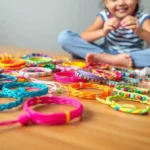Navigating the world of “determinethequantityofin” might sound like a math problem that even Einstein would raise an eyebrow at. But fear not! This isn’t rocket science—it’s more like a fun puzzle waiting to be solved. Whether you’re a curious learner or someone who’s just stumbled upon this quirky phrase, understanding how to determine quantities can be both enlightening and entertaining.
Table of Contents
ToggleOverview of Determinethequantityofin
“Determinethequantityofin” encompasses the process of identifying specific amounts in various contexts, often relying on quantitative analysis. This concept applies to fields such as mathematics, science, and even everyday decision-making. Knowledge of how to quantify enhances understanding and provides valuable insights.
Quantifying involves measurements, calculations, and data interpretation. He, she, or they might consider factors like dimensions, weight, or volume depending on the scenario. Accurate assessments lead to better conclusions, whether in academic research or practical applications, such as ingredient proportions in recipes.
A variety of methods exist for determining quantities. Some common techniques include direct measurement, analytical calculations, and statistical models. Each approach offers unique advantages. For instance, direct measurement provides immediate results, while analytical methods can yield deeper insights through calculations.
Real-world applications showcase the importance of quantifying. In business, determining quantities of inventory affects stock management and profitability. Scientists rely on accurate measurements to validate hypotheses and conduct experiments. In education, students learn to apply these skills through problem-solving exercises that involve real-life scenarios.
Collaborative efforts often enhance the ability to determine quantities. Team discussions can foster diverse perspectives, leading to innovative solutions. Sharing insights and methodologies improves accuracy and efficiency in quantification tasks.
Understanding how to determine quantities equips individuals with essential skills for analysis and decision-making. Mastering these techniques not only benefits professionals but also enriches personal knowledge across various applications.
Importance of Determinethequantityofin

Understanding how to determine quantities holds significant importance across multiple domains. This process enhances problem-solving capabilities and decision-making effectiveness.
Applications in Various Fields
Determining quantities finds applications in diverse areas, such as engineering, healthcare, and economics. In engineering, accurate measurements prevent structural failures. Healthcare professionals rely on precise dosages for medications, ensuring patient safety. Economists perform quantitative analyses to forecast market trends, shaping business strategies.
Data-driven decisions arise from effective quantity determination. Educational settings utilize this concept in experiments and practical exercises, reinforcing learning through hands-on experience. Each application demonstrates how mastering this skill brings clarity and efficiency.
Benefits of Accurate Determination
Accurate determination of quantities offers numerous benefits. First, it promotes informed decision-making across professional realms. For example, businesses that assess inventory accurately minimize waste and optimize resources.
Second, improved accuracy enhances research validity. Results derived from sound quantitative analysis yield reliable conclusions that advance knowledge. Third, individuals benefit personally by applying these skills in everyday tasks, such as cooking or budgeting. The ability to quantify effectively supports success in both professional and personal contexts.
Methods to Determinethequantityofin
Determining the quantity of something involves various methods suited to the context. Different approaches can enhance accuracy and effectiveness.
Quantitative Techniques
Quantitative techniques focus on numerical data, allowing for precise measurement. These methods include direct measurement using tools such as scales or rulers. Additionally, individuals can apply formulas to calculate quantities based on known variables. For instance, statistical analysis can estimate inventory levels in a business setting. Data-driven insights facilitate informed decision-making, particularly in scientific contexts. Accuracy in numbers fosters confidence in research findings and practical applications.
Qualitative Assessments
Qualitative assessments involve non-numeric evaluations, emphasizing descriptions and characteristics. Observational techniques play a crucial role in understanding qualities that quantitative data might overlook. For example, sensory evaluations assess product quality by examining texture or aroma. Engaging with focus groups can gather subjective insights, offering diverse perspectives on preferences. These assessments complement quantitative results, enriching analyses and decision-making processes. Combining both methodologies leads to a more comprehensive understanding of quantities in various circumstances.
Challenges in Determining the Quantity of In
Determining the quantity of in presents various challenges that can complicate the process. One major issue involves the accuracy of measurements, especially in dynamic environments. Error rates can increase when relying solely on manual methods, leading to discrepancies in results.
Reliability of tools and equipment also affects outcomes. Faulty or improperly calibrated instruments can yield incorrect data, requiring cross-verification with alternate methods. Variability in external factors, such as temperature or humidity, can further complicate consistent measurements.
Subjectivity in qualitative assessments introduces additional challenges. Personal bias may influence evaluations, affecting the final quantity decision. Relying on human judgment sometimes leads to inconsistency, especially in descriptive analysis.
Understanding the specific context is crucial for accurate quantity determination. Contextual factors can significantly alter the perception of what constitutes an appropriate or necessary measurement. Furthermore, inadequate training or knowledge about methodologies can hinder effective application of quantitative techniques.
Collaboration among diverse teams can mitigate some challenges. Shared perspectives often enhance understanding and lead to more accurate results. Engaging multiple experts allows for cross-examination of data, reducing the likelihood of errors.
Availability of resources and time constraints may also pose significant challenges. Limited access to necessary tools or data can impede the overall process, making timely decisions difficult. Balancing the need for accurate measurements against time limitations remains a prevalent hurdle.
Addressing these challenges requires a strategic approach. Combining quantitative and qualitative methods can lead to a more comprehensive understanding of quantities. Overcoming obstacles in determining quantities enhances effectiveness across fields ranging from scientific research to everyday tasks.
Future Directions in Research
Research on determining quantities has many promising avenues worth exploring. Innovations in technology can streamline measurement processes, making them more efficient. Next, integrating machine learning models might enhance accuracy in predictive analytics, allowing for real-time data interpretation. Expanding studies on qualitative assessments can provide richer insights into subjective evaluations.
Collaboration among interdisciplinary teams becomes vital for tackling complex challenges. Increased focus on data visualization methods can improve understanding, making quantitative results more accessible. Additionally, exploring the psychological factors influencing decision-making might reveal biases impacting quantity assessments.
Adaptive methodologies can enhance data collection in dynamic environments. Further investigation into tool reliability will lead to recommendations for standardized practices across various fields. Understanding cultural differences in quantity perception could deepen insights into global applications.
Small-scale experiments may yield practical techniques adaptable to personal tasks, such as cooking or budgeting. Continuous training in quantitative and qualitative methods ensures researchers stay equipped to effectively navigate evolving challenges. Prioritizing these future directions will enrich the understanding of quantity determination, facilitating informed decisions in both professional environments and everyday life.
Mastering the art of determining quantities is essential for effective decision-making across various fields. Whether in scientific research, business, or everyday tasks, accurate measurements empower individuals to make informed choices. By blending quantitative and qualitative methods, one can enhance their understanding and tackle challenges more efficiently.
Looking ahead, technological advancements promise to simplify measurement processes and improve data analysis. Embracing interdisciplinary collaboration will further enrich the exploration of quantity determination. As individuals continue to refine their skills in this area, they’ll unlock new opportunities for success in both professional and personal endeavors.








